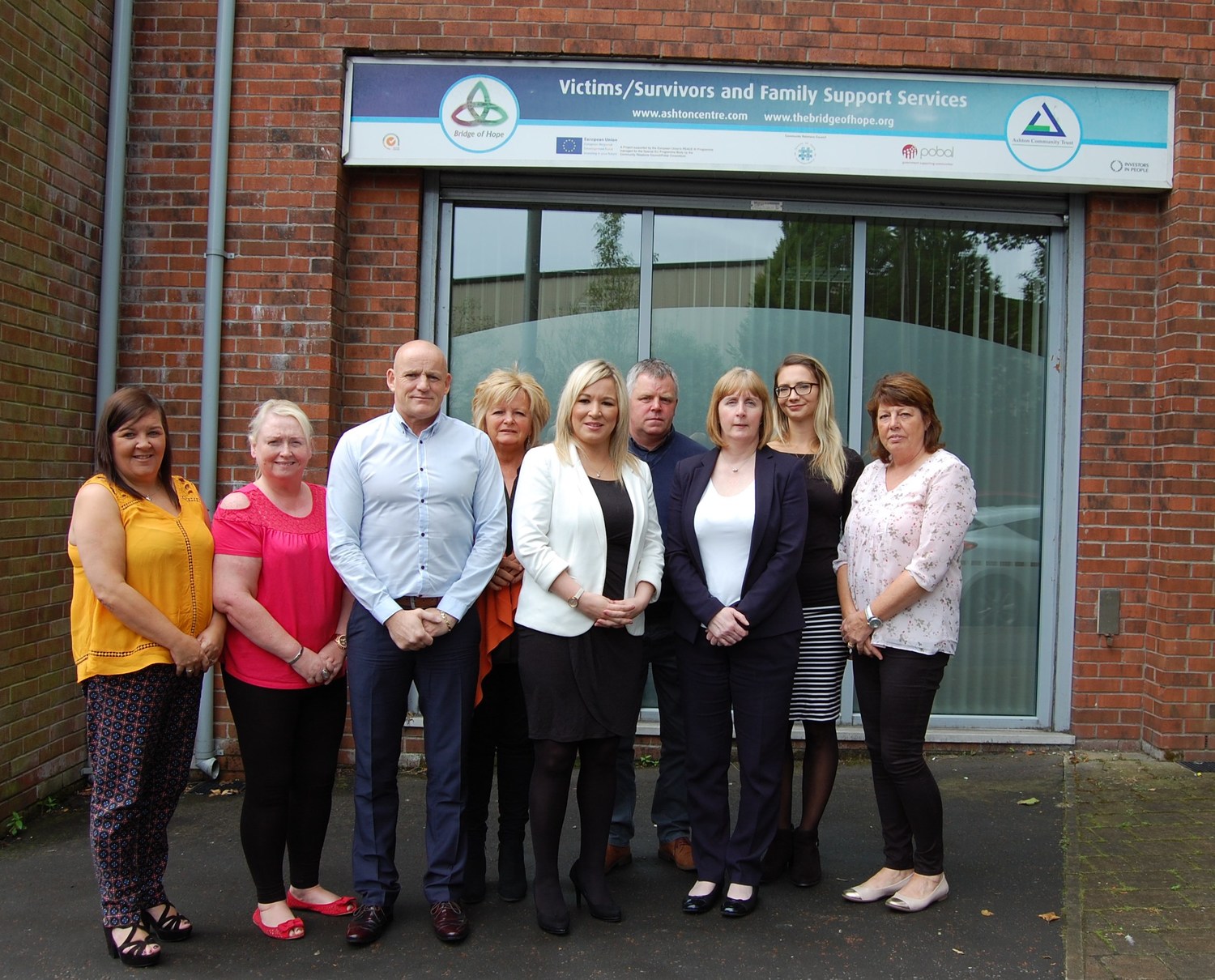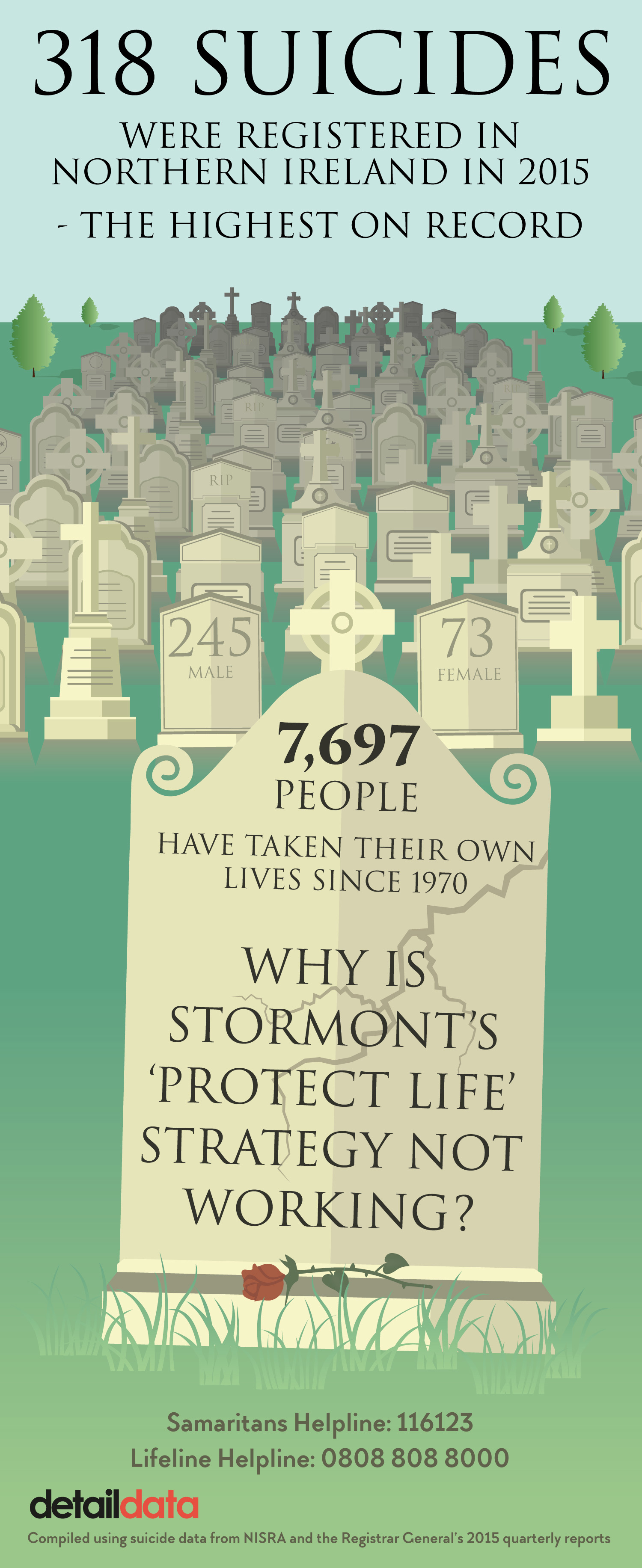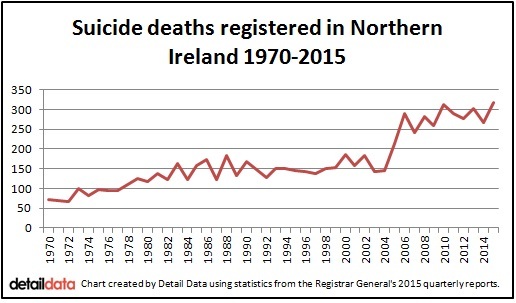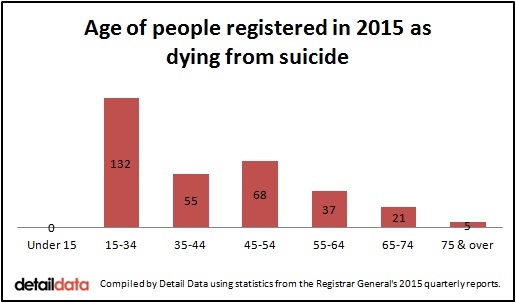THREE hundred and eighteen suicides were registered in Northern Ireland during 2015 – the highest annual death toll since records began in 1970.
Despite over £7m being spent annually on suicide prevention, the equivalent of six people each week took their own lives here last year.
This was a 19% increase on the suicides recorded in 2014.
Detail Data is reporting on the latest suicide figures almost 10 years after Northern Ireland’s Protect Life suicide prevention strategy and action plan was launched in October 2006 in response to the increasing rate of suicide. Over £50million has been allocated to suicide prevention since the strategy started.
Of the suicide deaths registered in 2015, 77% (245) were male. One hundred and thirty-two were aged between 15 and 34-years-old and five people were 75 or older.
Ninety-three people who took their own lives lived in the Belfast Health Trust area - this is 30% of the 2015 total.
Suicide rates in the most deprived areas of Northern Ireland are three times higher than the least deprived.
There is no simple explanation for why someone chooses to die by suicide and it is rarely due to one particular factor. Mental health problems are important influences, as well as alcohol and substance misuse, feeling desperate, helpless or without hope.
Using historic data held by the Northern Ireland Statistics and Research Agency (NISRA) we have been able to calculate that a total of 7,697 suicides were registered in Northern Ireland from the beginning of 1970 to the end of 2015. Of these deaths, 5,666 were males.
Statistics from the Self-Harm Registry also show that between April 2014 and March 2015 there were 8,888 self-harm presentations to emergency departments in Northern Ireland, involving 6,633 people. Young people aged 15-29 accounted for almost half (46%) of all of these cases.
In response to the figures, Health Minister Michelle O’Neill said the suicide rate was “unacceptably high in the north" and that reducing the rate continues to be a priority for her department.
“High levels of deprivation, the legacy of conflict and high levels of mental ill-health create a very challenging set of circumstances for many people in the north of Ireland,” she said.
Caroline King from counselling service Contact NI stressed that people can be saved from suicide.
"It is so important to focus on hope and recovery for people. One death from suicide is one too many," she said.
The Detail last reported on suicide deaths in 2014 when we revealed that almost as many people had died from suicide in Northern Ireland since the signing of the Good Friday Agreement as were killed during the entire Troubles.
THE FIGURES
Today’s report is based on the suicide statistics from the Registrar General’s four quarterly reports for 2015. These reports contain figures on key life events in Northern Ireland - births, stillbirths, deaths, marriages and civil partnerships.
Suicide deaths can take time to be fully investigated and there is often a period of time between when the suicide occurs and when it is registered. For example, of the 268 suicides registered in 2014, 133 actually occurred in 2014, 123 took place in 2013 and 12 in 2012 or earlier.
In Northern Ireland and across the rest of the UK, reported suicides include cases where the cause of death is classified as either ‘intentional self-harm’ or ‘event of undetermined intent’.
The 2008/11 Programme for Government (PfG) set the target of an average annual suicide death rate of 10.7 per 100,000 of population over the three year period 2010 to 2012. This target was not achieved with the rate increasing instead to 16 deaths.
Using the new 2015 data, we have calculated that the suicide rate remains at 16 deaths for 2013-15.
The word ‘suicide’ does not appear in either the 2011/15 PfG or the draft 2016/21 PfG. The Health Minister said it is expected that the suicide rate will be one of the indicators used to monitor the implementation of the PfG.
Minister O'Neill said that the suicide rate has "remained steady" since the launch of the Protect Life strategy in 2006.
"Undoubtedly, lives have been saved through Protect Life services, but it is not possible to estimate how many," she said.
“Efforts to reduce the rate of suicide here need to include broader intervention to improve the life chances and circumstances for more of our people, particularly those who live in deprived areas or who face social exclusion or prejudice.
“This approach must be combined with effective services for identifying people who are at risk, and ensuring they are provided with the support and care necessary to recover from suicidality. Suicide prevention will continue to require action across all government departments.”
The Minister confirmed that the new 'Protect Life 2' strategy is expected to be issued for consultation in September 2016. Final publication of the strategy is due in 2017.
Click here to read the Minister's full response to our questions.

Health Minister Michelle O'Neill met with community groups at Bridge of Hope in north Belfast last month to discuss suicide prevention
HOPE AND RECOVERY IN BELFAST
High numbers of suicide deaths have devastated families across Belfast, particularly in the north of the city.
The Belfast Forum for Suicide Prevention is made up of more than 30 community and voluntary groups who are working together to combine their expertise, experience and resources to reduce suicides.
Forum members Irene Sherry, Stephen Barr, Caroline King, Clare Flynn and Jo Murphy spoke to Detail Data.
Irene Sherry, from Bridge of Hope, Ashton Community Trust in north Belfast, said: “Behind the suicide figures are individuals and their families.
“We have been lobbying strongly for a cross-departmental approach to suicide prevention that collaboratively works with the community sector and there has been a lot of active listening and engagement taking place. We have met with the Chief Medical Officer Dr Michael McBride twice and the Health Minister Michelle O’Neill within the last month.
“Social and economic deprivation, poverty, unemployment and the legacy of the conflict all play a part in the complex issue that is suicide and that is why we need a cross-departmental approach. We want to build the resilience of individuals, families and communities and we need a long term vision.”
Start360’s Stephen Barr said: “It is complex and emotive and there are huge challenges ahead for the Department of Health. We need to get to grips with the issue of suicide and poor mental health.
“It is so important to link in with and collaborate with people on the ground. We need to ensure the key messages feed down so that when people are in a situation of despair they know that there is help out there if they want to reach out. It is imperative that suicide remains high on the government’s agenda.”
Caroline King, from Contact NI, said: “When someone dies from suicide, all of us working in this field have a great support system which goes out to families but we shouldn’t have anyone dying from suicide because there is help and support available. Thousands of people come through our door every year with suicidal thoughts and they do recover.
“There is a lot of amazing work being done in the statutory, voluntary and community sector and people can access help through their GPs, community centres and churches but there are people who don’t go to these places and it is them that we need to reach.
“It is very brave for people to say they are feeling low and have considered taking their own life. We work with brave people every single day and they receive help and support.
“We can save people from suicide; It is so important to focus on hope and recovery for people. One death from suicide is one too many.”
Clare Flynn, a suicide prevention development officer in east Belfast, said: "One of my concerns is that the current structure of services in Belfast leaves gaps in the services delivered across the city.
"Each area needs to be resourced for the delivery of early intervention, prevention, crisis services and support for those bereaved by suicide. We have several examples of best practice across these themes but these aren't yet being replicated in each local area due to the current funding structure.
“Members of the public also have a skewed perception of who is at risk of suicide. It’s not just young people and it’s not just people who take drugs. To label one thing as the cause of suicide is unhelpful and creates stigma.
“It is always much more complex and one of our challenges is to let the public know that suicide prevention is an issue for all of us and we want to try and save lives. It would be great if we had high profile champions speaking out who have dealt with a suicide crisis and come out the other side.”
Jo Murphy from Lighthouse said: “I think we need to get back to basics and look at how we build our communities. We need to skill people up to look out for each other. Some people don’t even know who their neighbours are. We also need to let people know that it’s okay to seek help."
A ‘Future Search’ event will take place in Belfast in September to bring together a large collective of people to plan for innovative ways to address suicide.
TACKLING THE ‘SUICIDE MYTHS’
Pat McGreevy, from the Suicide Down to Zero charity based in Downpatrick, said the 2015 figures were “very concerning”.
"There is a lot of great suicide prevention work being done and it could be argued that, without this, the numbers dying from suicide could be even higher,” he said.
"Suicide has a huge impact on the families bereaved in this way. Often the hopelessness that their loved ones experienced, they too experience it. Families are also left with the terrible question of ‘why?’, which they may never get to know the answer to. Very often the last time they saw the person they were in good form and seemed to be okay.
"With appropriate help people bereaved in this way can get to a new normal, where they can once more enjoy life. Their lives have changed forever and it’s a life their loved one will not share.”
Mr McGreevy said it is time to think about new and different approaches to suicide prevention in Northern Ireland.
"There are a lot of myths surrounding suicide that need to be challenged in a specific public information campaign. These myths include notions that talking about suicide puts it in people’s heads, that people who talk about suicide aren’t serious, that they may be attention seeking and that only professionals can deal with people who are suicidal.
"These all represent barriers to suicide prevention and reinforce stigma around the issue.
"Cancer and HIV/AIDS used to be big taboo subjects in society until people began to talk about them openly. In other parts of the world there seems to be more readiness to encourage people to talk about suicide more openly. We have to tackle the issue openly and directly in a careful and considered way.
"If we are serious about preventing suicide then it has to move further up the political agenda. More specific resources need to be devoted to the early and ongoing support for bereaved families. Further investment is also needed in suicide prevention training to identify people who may be at risk and for those who have survived suicide attempts.
"The economic cost of suicide has been estimated at around £1.5m for the loss of a single life to suicide. That would be a loss of £4.3billion over the last 10 years. That is a staggering amount of loss to the economy here alongside the immense human cost.”
• To access the suicide data in full, click here.
HELPLINE DETAILS
- Lifeline is the Northern Ireland crisis response helpline service for people who are experiencing distress or despair. It can be contacted confidentially on 0808 808 8000.
- The Samaritans can be contacted by telephone on 116 123 or email [email protected]
- Suicide Down to Zero can be contacted on [email protected]





